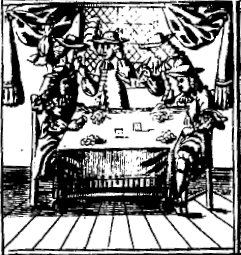So here's the thing. We don't really expect fallibility from computerized systems, and for scholars such systems increasingly mean online databases. I've grown to trust the MLA database, Google Scholar, the OED, etc. How else can we know what has been written and where we can join a scholarly conversation? But these databases are only as good as the data that is put into them, mostly by imperfect humans. That means that they tend to err in omission rather than in commission. If something appears in a database, it definitely exists. But if it doesn't appear in a database, it may still exist. This is a lot like pregnancy tests that have false negatives but never a false positive. I can use my own work as an example. My dissertation (UVa 1995) appears in the MLA database because it was indexed by
Dissertation Abstracts International (DAI). It also appears in the UVa library catalog where the only paper copy (other than my own) resides. But it does NOT appear in a WorldCat Dissertation search, nor does it appear in a Google Scholar search (possibly because Google Scholar relies on WorldCat). Why? Who knows? Conversely, my very first published article, on early modern stigmatics and politics (
Viator 2000) turns up in a Google Scholar search (use "MacInnes" and "Nun of Portugal") but only in a French database. It's not recorded in the MLA database even though the MLA does index
Viator. For some reason, only one article from the whole 2000 edition made it into the database. Is this because some of the articles are not deemed to be literary? Who knows. What all this means is that it's really difficult to determine what has not been said on a given topic. One can try a variety of searches, but even if each one returns a negative result, it doesn't mean the information does not exist. Perhaps, given the amount of information that is now being put online, the newest kind of research will operate on the basis of finding and using "hidden" sources, the things that fell through the cracks in the digital world. They will be really hard to find!





 As a useful endpoint, I read John Arbuthnot's 1692 book Of the laws of chance. This was the first English publication on probability theory. It is mostly a translation of Huygens (1657), but of course Arbuthnot's introduction is his own. I think some of the examples are his as well. There are two things that struck me about this piece. The first is the extent to which Arbuthnot claims that mathematical probability applies to the world at large. "All the Politicks in the World," he says "are nothing else but a kind of Analysis of the Quantity of Probability in casual Events." The second is the degree to which he employs economics to convey his ideas. His most basic principle is that ""Ones Hazard or Expectation to gain any thing is worth so much, as, if he had it, he could purchase the like Hazard or Expectation again in a just and equal Game" (B2). This sounds confusing, but he gives an example to make it clear. If someone has hidden seven shillings in one hand and three in the other and says "choose one hand and I'll give you the contents" Arbuthnot argues that this is equivalent to being given five shillings. This means that chance itself has a value predicated on exchange. He's not really thinking of commodification as much as fungibility. This is the real epistemological revolution behind the idea of probability. It's what I need to look for in earlier accounts.
As a useful endpoint, I read John Arbuthnot's 1692 book Of the laws of chance. This was the first English publication on probability theory. It is mostly a translation of Huygens (1657), but of course Arbuthnot's introduction is his own. I think some of the examples are his as well. There are two things that struck me about this piece. The first is the extent to which Arbuthnot claims that mathematical probability applies to the world at large. "All the Politicks in the World," he says "are nothing else but a kind of Analysis of the Quantity of Probability in casual Events." The second is the degree to which he employs economics to convey his ideas. His most basic principle is that ""Ones Hazard or Expectation to gain any thing is worth so much, as, if he had it, he could purchase the like Hazard or Expectation again in a just and equal Game" (B2). This sounds confusing, but he gives an example to make it clear. If someone has hidden seven shillings in one hand and three in the other and says "choose one hand and I'll give you the contents" Arbuthnot argues that this is equivalent to being given five shillings. This means that chance itself has a value predicated on exchange. He's not really thinking of commodification as much as fungibility. This is the real epistemological revolution behind the idea of probability. It's what I need to look for in earlier accounts.












 On the bright side, I've been reading James Branch Cabell's
On the bright side, I've been reading James Branch Cabell's 